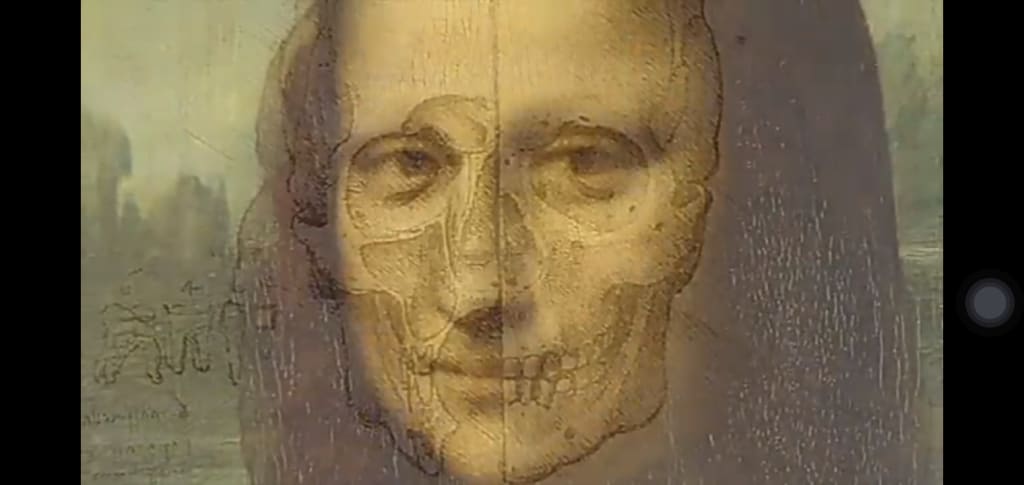
If we take the copy and overlay the two, we get some idea of what the Mona Lisa we put one picture of the Mona Lisa on top of another picture of the Mona Lisa, and we can get an idea of what it might look like combined. If it was possible to make her look the same as she did before.
Now we can see the pink lips that Vasari described in 1550, and the slim figure. Someone wrote about how the Mona Lisa may have had eyebrows and eyelashes at some point.
Leonardo liked to arrange his paintings in a triangle shape, like a pyramid. This was a new and special way to paint during his time. The building helps keep everything in place and also helps us know where to look. In the Mona Lisa painting, it makes us focus on her face. Leonardo was the first to use a pose where the person is not standing straight but is slightly turned to the side. A portrait is a picture of someone that shows their whole face and body. People used to make portraits like this all the time.
But why? Because they wanted to show the person's whole body in the picture. The frame helps focus on the main thing in the painting and makes it feel more personal by getting rid of things that might get in the way. In Italy, people started standing a certain way with their bodies for a long time, about 400 years. Today when we see how Mona Lisa is sitting in the painting, it looks pretty normal. But back when the painting was made, it was very different and special. Before this, people in paintings used to sit very straight and proper, but Mona Lisa looks very relaxed and casual with her hands. Her hands are sitting calmly on the arm of her chair, and she is looking at us like a picture is being taken. Mona Lisa looks happy and confident, like how rich men were usually shown in pictures. Back in the Renaissance period, paintings of women were usually shown from the side and they weren't smiling. We are staring into her eyes and she is staring back at us. Women in the picture are looking at us. The paintings didn't look straight at you, they were more subtle. The painting was different from how people usually painted women in Italy.
Also, portraits were usually drawn with a plain background like the sky or a simple room. The Mona Lisa painting shows a made-up scene that Leonardo da Vinci dreamed up in his mind. In paintings during this time, everything in the picture looked very clear and detailed, both the main thing being painted and the background. The background of the Mona Lisa looks very real because it is made to trick your eyes into thinking it is lifelike. Leonardo da Vinci was the first person to talk about how things look farther away or smaller in drawings, which helps show depth and distance. If he didn't create it, he made it even better. The big landscape behind the Mona Lisa. The story continues to faraway icy mountains. The only signs that people have been there are a path and a bridge. Her hair and clothes look like the hills and rivers in the background. Leonardo da Vinci liked to talk about how humans are connected to nature, both in small ways and big ways. He figured out how a heart valve closes by studying how fluids move. To help a child understand, we will also talk about how heavy, big, and which way the hair curls. The twist. The river on the right side of the earth flows into the scarf that is wrapped around her left side. If it were possible to restore her. Now we see the "rosy lips" described by Vasari in 1550, and the "thin eyebrows and eyelashes" he wrote about. Suggesting that indeed the Mona Lisa once had eyebrows. Leonardo uses the classic "pyramid shape" composition that was introduced during the Renaissance. It is an important change from the paintings of the 15th century. The structure provides stability, but more importantly, it provides a clear central focus and directs your gaze.
In Mona Lisa's case, it is pulling us into her face.
In this art, the person is shown from about three-quarters of the way instead of showing their whole body. A portrait is a picture of someone's face from the side. This was the standard way of drawing people at that time.
But why? Because the person in the picture takes up the whole space. The frame around the painting helps to make the picture more focused on what is important and less busy. For 400 years in Italy, people liked to stand with their bodies turned three-quarters of the way around. Today, when we see the way Mona Lisa is sitting in the painting, it looks like a regular way to sit. But back when the painting was made, it was very different and new. Before, people in paintings stood up straight and looked very proper. But Mona Lisa is sitting in a more relaxed way, with her hands resting on her lap. She is sitting in a chair with her hands resting on the arm, and she looks like she is posing for a picture.
The Mona Lisa looks happy and confident, like how wealthy men were usually shown in paintings. In old paintings, pictures of women were usually from the side and they didn't show their teeth when they smiled. We are looking at her eyes and she is looking at us too. Paintings didn't usually show people looking straight at you with confidence.
The painting was different from how people usually painted women in Italy. Portraits used to be drawn with either a plain background like the sky or a simple room behind the person. The Mona Lisa painting shows a beautiful background that Leonardo da Vinci made up in his mind. In paintings from this time, everything in the picture looks very clear and detailed, both the main thing being shown and the things in the background. The background of the Mona Lisa looks very real because it tricks our eyes into thinking it's a detailed scene. When things look far away, they seem smaller and less detailed. Leonardo da Vinci was the first to talk about this idea. He didn't create it, but he made it even better. The large background behind the Mona Lisa. Walk to far away snowy mountains. The only way to get there is a path and a bridge made by people. Her hair and clothes look like the hills and rivers in the background. Connecting people and nature. Small things and big things, a topic that Leonardo liked to talk about. He used his special studies about how water moves, to figure out how a heart valve closes. To help a child understand, we can also talk about how heavy, big, and which way the curls of hair are twisted. The shape of the earth is like the shape of a person's body. On a close look at the river on the right. It goes into the scarf on her left. When we look at the picture, we can see that the girl's shoulder is touching the ground.
The background of the picture is also based on science. Leonardo studied layers of rocks in the Apennines. This was long before Darwin. Scientists have learned from studying rocks and fossils that the world is much older than what Genesis says in the Bible. Because he knows a lot about rocks and earth, he makes sure there are no mistakes in the background he draws. Even though the scenery in the background looks like it should match up perfectly with the person in the front, there is a slight difference in how they line up. The girl's head is a little crooked, but her shoulders look straight. Leonardo liked to play tricks with how things looked in his paintings. It looks like things are moving, but they're not really moving. Leonardo understood this visual information: We know that the horizon should line up so we read it as level. This causes us to interpret the shoulders as being on a slant - which they are not.
The Mona Lisa painting by Leonardo da Vinci shows that he believed everything in the world is linked together. Being able to use your brain and creativity together. Art and science come together in one piece.
This picture of a fancy lady started as a simple painting, but now it's turned into something more special. Art is like a never-ending story that we create and share with others. Leonardo da Vinci believed that we may never feel completely satisfied with our art, but that's okay because it's meant to be shared and enjoyed by everyone.
It makes sense that a painting made by a man who always kept learning new things; even 500 years after it was made, still teaches us something important, though there are many stories about it. There are stories about her that people believe, but we are finding out more about her through science and research.
Who knows? One day we may see the Mona Lisa exactly the way Leonardo saw her!
About the Creator
Enjoyed the story? Support the Creator.
Subscribe for free to receive all their stories in your feed. You could also pledge your support or give them a one-off tip, letting them know you appreciate their work.






Comments
There are no comments for this story
Be the first to respond and start the conversation.